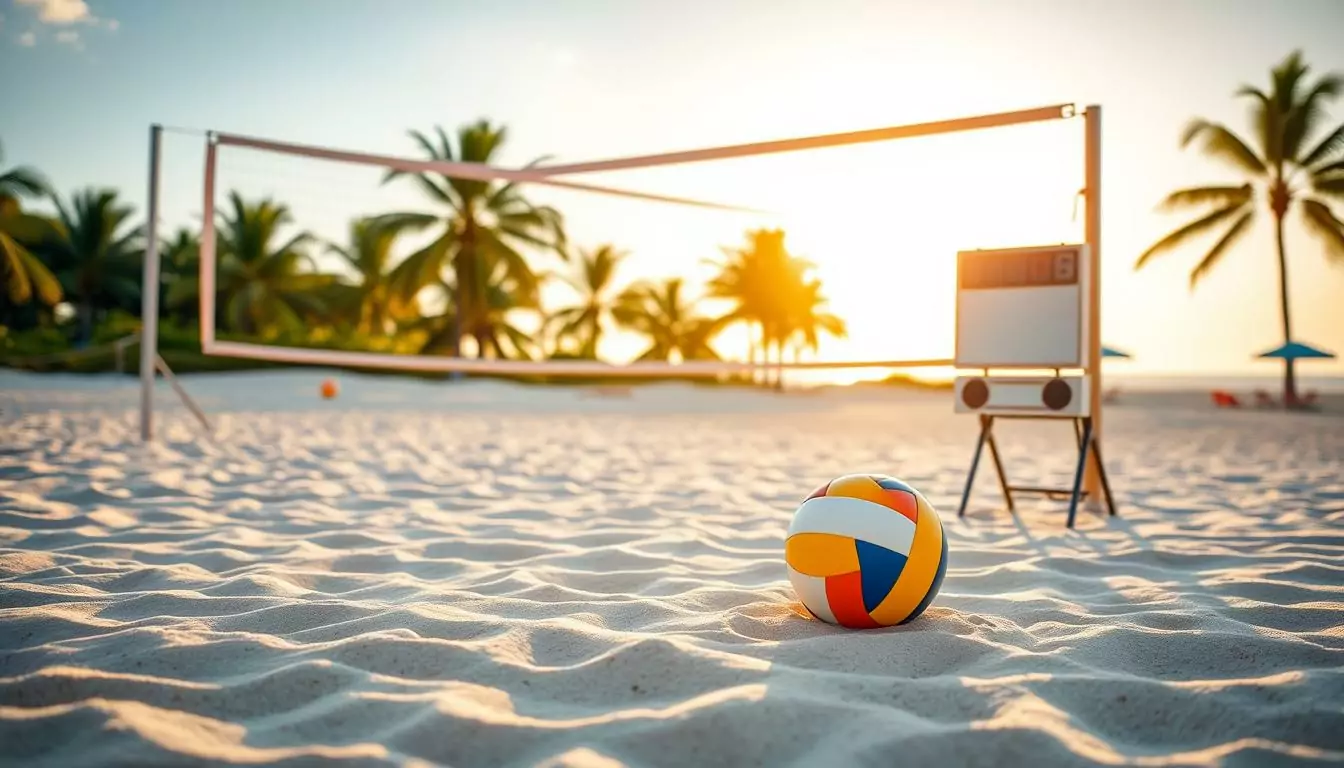The “First Touch” volleyball for 1st graders weighs only 0.5 ounces. This fact shows how diverse volleyball equipment can be. Outdoor volleyball offers many experiences for players of all ages and skills.
Knowing outdoor volleyball rules, gear, and techniques is key for any game. This guide covers the basics. It will help you prepare for different surfaces and game types.
Outdoor volleyball includes beach, grass, and snow variants. Each type has its own challenges and gear needs. Court sizes, net heights, and ball specs differ across formats.
Playing styles change based on the environment. Beach volleyball needs different skills than indoor games. You’ll learn how to adapt to sand, grass, or snow courts.
This guide covers all parts of outdoor volleyball. It includes choosing the right ball and setting up a court. You’ll also learn about pro gear and how to keep it in good shape.
Key Takeaways
- Volleyball equipment varies significantly based on player age and skill level
- Court dimensions and net heights differ for various outdoor volleyball formats
- Specialized gear is required for beach, grass, and snow volleyball variants
- Understanding outdoor volleyball rules is essential for proper gameplay
- Proper equipment maintenance ensures longevity and optimal performance
- Volleyball techniques and strategies must be adapted for different outdoor surfaces
Understanding Different Forms of Outdoor Volleyball

Outdoor volleyball offers various exciting forms with unique characteristics. The sport adapts to different environments, from beaches to snowy slopes. Players and spectators can enjoy diverse experiences in these settings.
Elite Beach Volleyball: Professional Standards and Rules
Beach volleyball tournaments are key in professional outdoor volleyball. The court is smaller than indoor volleyball, measuring 16m x 8m. Professional setups use ground sleeve methods for net poles to ensure stability.
| Aspect | Measurement |
|---|---|
| Court Size | 16m x 8m |
| Net Height (Men) | 2.43m |
| Net Height (Women) | 2.24m |
NCAA Beach Volleyball: Official Regulations and Competition Structure
NCAA beach volleyball follows rules similar to professional beach volleyball. It became an official NCAA championship sport in 2016. This has led to more beach volleyball tournaments at the collegiate level.
Snow Volleyball: The Winter Variant and Unique Equipment Needs
Snow volleyball is an exciting winter variant played on snowy terrain. It uses a best-of-3 sets format, with each set played to 15 points. Teams have three starters and one substitute, adapting the sport to colder climates.
Grass Volleyball: Equipment Choices and Surface Considerations
Grass volleyball blends elements of indoor and beach volleyball. It’s played on grass courts, requiring different equipment choices. The softer surface affects player movement and ball dynamics, creating a unique experience.
Each form of outdoor volleyball brings its own challenges and excitement. Understanding these variations will enhance your enjoyment of the game. Try different types to find your favorite!
Essential Volleyball Equipment Guide
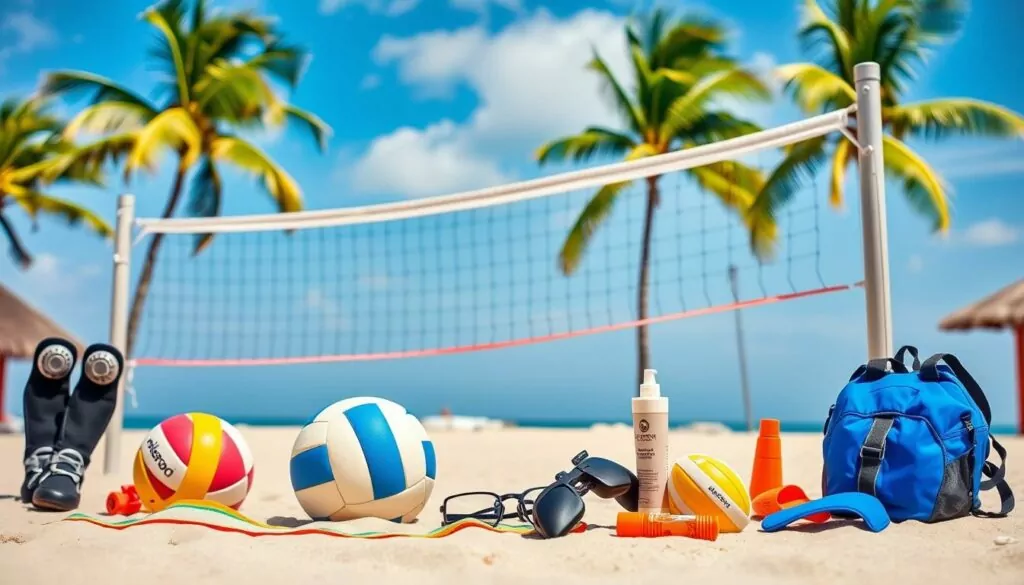
Volleyball gear is vital for fun and safe play. The right equipment can make your game great, whether on sand or indoors.
Professional Volleyball Net Systems and Setup Requirements
Pro volleyball nets meet specific standards. For men, the net stands at 2.43m (7.97ft) high. Women’s nets are set at 2.24m (7.35ft).
These heights ensure fair play across all levels. They’re crucial for official competitions and practice sessions alike.
Selecting Tournament-Grade Volleyballs for Different Surfaces
Picking the right volleyball is key to playing well. FIVB-approved balls weigh 260-290 grams and measure 65-67cm around.
The ideal ball pressure is 4.3-4.6 psi. Brands like Mikasa and Wilson offer quality volleyballs for various surfaces.
Complete Volleyball Sets for Every Skill Level
Volleyball sets suit different skills and places. Beginners can use portable sets from Park & Sun Sports for easy practice.
Pro players need special gear. This includes volleyball shoes, knee pads, and training tools like Tandem Sport Pass Rite.
- Volleyball-specific shoes from ASICS, Mizuno, or Nike
- Protective gear like Nike Essentials Volleyball Knee Pads
- Training equipment such as Tandem Sport Pass Rite for skill development
| Equipment Type | Beginner | Professional |
|---|---|---|
| Volleyball | Standard size, any brand | FIVB-approved, Mikasa or Wilson |
| Net System | Portable set | Professional system with precise height adjustment |
| Shoes | General athletic shoes | Volleyball-specific from ASICS, Mizuno, or Nike |
| Protective Gear | Basic knee pads | Advanced knee pads and ankle braces |
Outdoor volleyball rules may differ from indoor play. Check local rules when setting up your court outdoors. Choose the right gear for your playing environment.
Setting Up Your Outdoor Volleyball Court
Creating an outdoor volleyball court requires careful planning and attention to detail. Proper dimensions and rules ensure fair and enjoyable gameplay. Let’s explore the key elements of setting up your court.
Court Dimensions and Boundary Specifications
Standard outdoor volleyball courts measure 16m long by 8m wide (52ft 6in x 26ft 3in). The free zone around the court should extend 5-6m on each side.
This extra space allows for player safety and movement during intense matches.
| Court Element | Measurement |
|---|---|
| Length | 16m (52ft 6in) |
| Width | 8m (26ft 3in) |
| Free Zone | 5-6m (16ft 5in to 19ft 8in) |
Portable and Lightweight Volleyball System Options
Portable volleyball systems offer flexibility for players on the go. These setups usually include lightweight poles, a net, and boundary markers.
When selecting a system, prioritize ease of assembly and transportation for your convenience.
Configuring Multi-Team Net Setups
For multiple games, create a multi-court layout while maintaining standard dimensions. Leave adequate space between courts to prevent interference.
Set men’s nets at 7′ 11 5/8″ and women’s at 7′ 4 1/8″ for regulation play.
By following these guidelines, you’ll create a regulation-compliant court ready for exciting matches and tournaments.
Tournament Organization and Competition
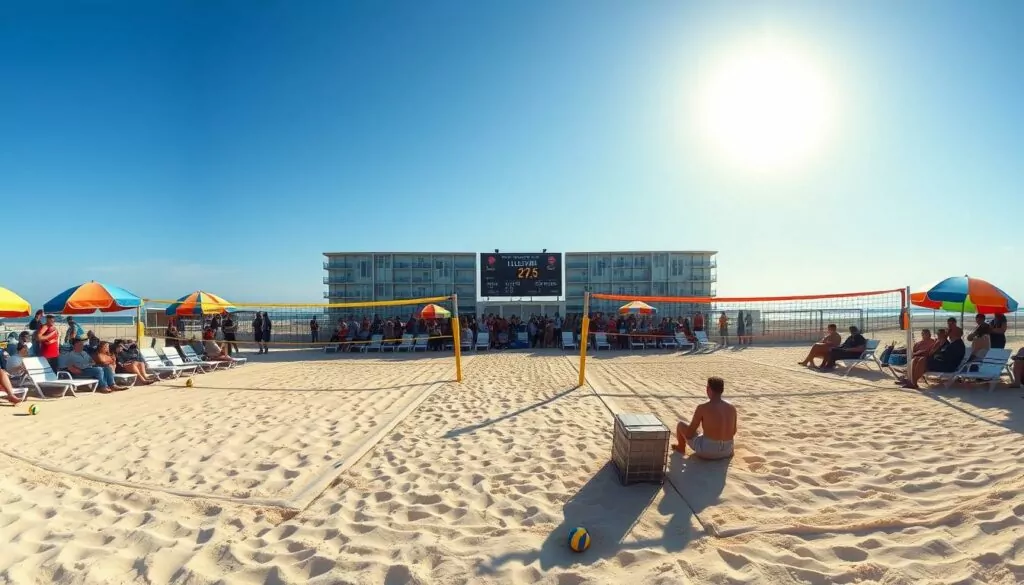
Beach volleyball tournaments need careful planning and official guidelines. The FIVB World Congress approved rules for 2021-2024, starting January 1, 2022. These rules cover court sizes, equipment specs, and game formats.
Professional Circuit Guidelines and Arena Setup
Pro beach volleyball tournaments need specific arena setups. The court is 16x8m with a 6m free zone. Warm-up court lighting must reach 1500 lux minimum.
At the Olympic Games Paris 2024, the beach volleyball venue will seat over 14,000 fans.
Tournament Director Responsibilities
Tournament directors manage many parts of beach volleyball events. They set up courts, handle team sign-ups, and oversee game tactics. Directors must know scoring, warm-ups, and team lineup rules.
Competition Equipment Standards
Beach volleyball gear must meet strict rules. Balls should follow set guidelines. Net height and post specs are key for fair play.
Here’s a breakdown of main equipment standards:
| Equipment | Standard |
|---|---|
| Playing Court | 16x8m |
| Free Zone | 6m from sideline and end lines |
| Lighting (Warm-up Courts) | 1500 lux minimum at 1m from ground |
| Ball Uniformity | As per FIVB standards |
Following these rules helps make beach volleyball tournaments fair and top-notch. Organizers ensure high standards by sticking to these guidelines.
Equipment Selection by Skill Level
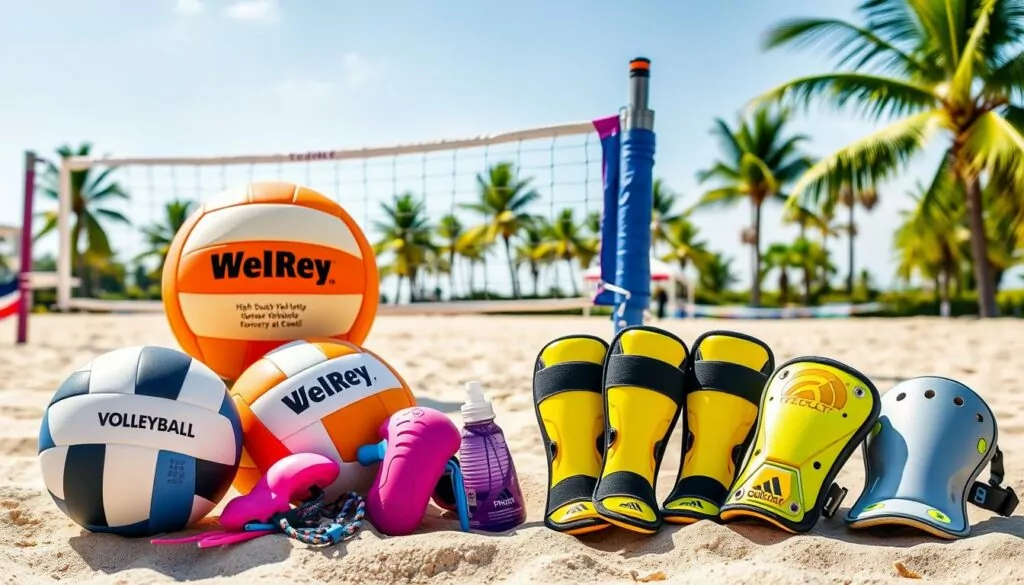
The right volleyball gear can make or break your game. It affects how well you play and how much fun you have. Let’s look at essential equipment for different skill levels and playing styles.
Recreational Player Equipment Essentials
Beginners need comfortable, durable gear. Start with a Tachikara SV-MNC Volley-Lite, a beginner-friendly volleyball. Add basic knee pads and comfortable athletic shoes to your kit.
Don’t forget a water bottle and towel for those sweaty matches!
Professional-Grade Gear Specifications
Elite players need top-notch equipment. The Mikasa VLS300, the Olympic beach volleyball, has a unique 10-panel design. For indoor play, the Molten FLISTATEC offers great control.
Pro-level knee pads, volleyball shoes, and high-quality nets are must-haves for competitive play.
Practice vs Competition Equipment
Practice and competition gear have similarities, but key differences exist. Practice gear focuses on durability and versatility. Competition equipment must meet strict rules.
For example, competition nets use 2.5mm polyethylene mesh. Practice nets might use 2mm mesh instead.
| Equipment Type | Practice | Competition |
|---|---|---|
| Volleyball | Tachikara SW5WSC | Mikasa VLS300 (Beach), Molten FLISTATEC (Indoor) |
| Net | 2mm mesh | 2.5mm polyethylene mesh |
| Antennas | Optional | Required (1.8m x 10mm fiberglass rods) |
| Court Boundaries | Flexible | Strict adherence to regulations |
Quality volleyball gear can boost your skills, no matter your level. Pick equipment that fits your style and helps you improve. Your game will thank you!
Maintenance and Care of Outdoor Volleyball Equipment
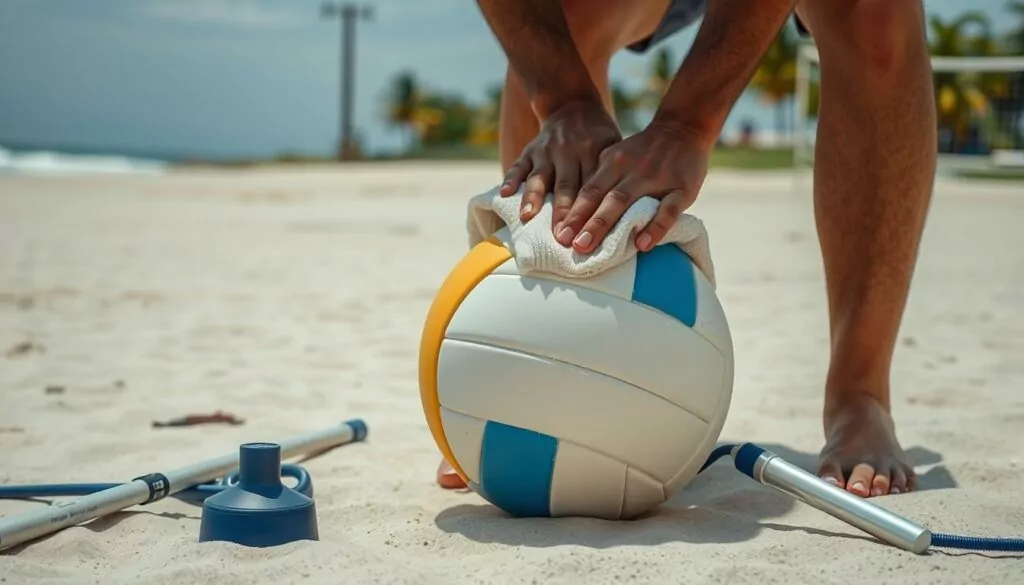
Proper care ensures your volleyball gear lasts longer and performs better. Let’s explore essential maintenance tips for outdoor volleyball equipment. These tips will help you keep everything in top shape.
Volleyball Net and Pole System Maintenance
Regularly inspect your net and poles. Galvanized volleyball posts are ideal for outdoor use due to their weather resistance. Clean the net and posts after each use to remove sand or debris.
Check for loose fittings or fraying in the net. Address any issues promptly to maintain safety and performance.
Proper Ball Care and Storage
Volleyball maintenance depends on the ball type. For laminated balls like the MVA200, wipe the surface with a soft, damp cloth. Avoid excessive moisture and heat to prevent panel peeling or discoloration.
Store balls away from direct sunlight and humid areas. This helps maintain their quality and performance.
For stitched balls like the VLS300, remove dirt and sand after use. When inflating, moisten the needle with glycerin to protect the valve. Proper care extends ball life and ensures consistent play.
Preserving Court Equipment
Beach volleyball setups need special attention. Store portable equipment properly when not in use. Maintain sand courts by raking and leveling the surface regularly.
For grass courts, keep the area well-mowed and free of debris. This ensures a safe and enjoyable playing surface.
| Equipment Type | Maintenance Frequency | Key Care Tips |
|---|---|---|
| Nets and Poles | After each use | Clean, check for damage |
| Laminated Balls | After each use | Wipe clean, store properly |
| Stitched Balls | After each use | Remove dirt, careful inflation |
| Court Surface | Weekly | Rake sand, mow grass |
Follow these guidelines to extend your volleyball equipment’s life. You’ll ensure safe, enjoyable play that follows outdoor volleyball rules. Your gear will thank you!
Conclusion
This guide covers essential outdoor volleyball knowledge. It includes equipment, types, and competition details. You’ll find information on court dimensions and gear specifications.
A standard volleyball court is 18 meters long and 9 meters wide. Net heights differ for men (2.43 meters) and women (2.24 meters). The volleyball weighs 260-280 grams with a 65-67 cm circumference.
This guide explores beach volleyball’s 2v2 format and full 6v6 matches. You’ll learn about player roles like setters, hitters, liberos, and blockers. It also covers scoring systems for various match types.
With this information, you can enjoy outdoor volleyball at any level. From fun beach games to professional competitions, you’re now prepared to play or watch.
